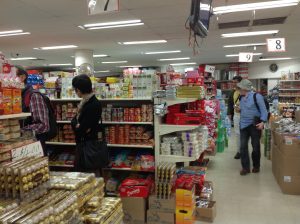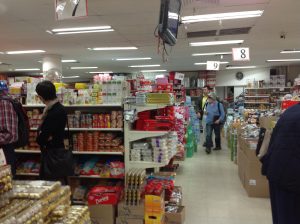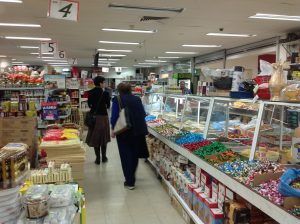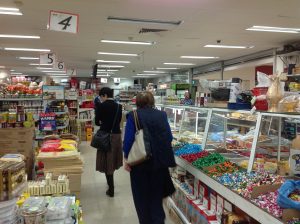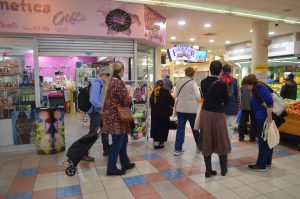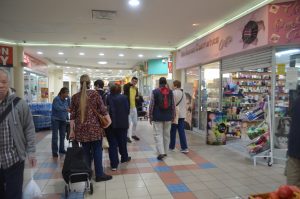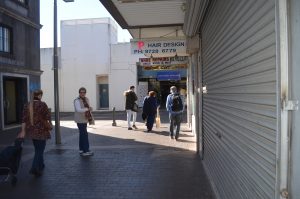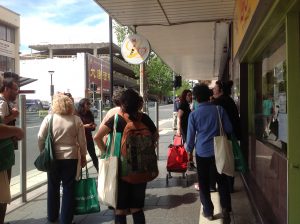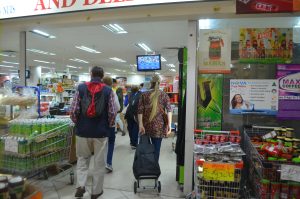Stepping Stones
In this final post, I briefly reflect on my posts as kinds of stepping stones to think about walking methods and walking work, particularly in relation to race and gender. My first step drew inspiration from blogs and studies of waitressing. Not only did these reveal the lively embodied skills of waiting on tables, the ways in which it not just our feet which walk but also our bodies which sway, swing, swerve, and sashay and the hurt of shoes and how these help or hinder our movements, scrunching our feet, squeezing our toes, letting us get a grip, holding us down, pushing us up, but they showed how a poetics in writing can animate the different styles of walking and embodiment. The authors got me thinking about how walking carries on after it has stopped and so Rose stresses the toll wreaked on his mother’s body for years after she waited on her last table, and Probyn still bends her body today into a waitress shape. They also brought the relationality of walking to the fore, describing how walking is not an individual act.
My second post was about shepherding, a mode of walking work performed by the ethnic tour guides to chivvy and pace the tourists’ walking. This involved stopping as well as moving. Rather than shoes and feet, I thought about space. This was particularly important given that the tours take place in stigmatized, racialised and ethnicised spaces and places of southwestern Sydney, I reflected on how walking makes space and space makes walking. In particular, I was interested in Sara Ahmed’s argument that space ‘opens up’ and ‘closes down’, taking different forms for racialised groups, stopping or enabling movements, and impressing and shaping bodies as they take the shapes of the spaces they occupy. Ahmed calls for us to think about the ‘historical racial scheme’ below embodied reality: thus,
‘white bodies are comfortable as they inhabit spaces that extend their shape… In other words, whiteness may function as a form of public comfort by allowing bodies to extend into spaces that have already taken their shape (2006: 158).
Finally, in the third stepping stone, I drew on ethnomethodological studies which illuminate how walking is ‘not all of a kind’. The focus becomes walking as the socially organised achievement of strangers and friends including for instance the socially organized achievement of not bumping into children, dogs, bikes, food stalls, shoppers Laurier et al 2016). In particular, I became alert to the ‘doing’ of walking with, walking together, and ‘togethering’. Laurier et al. remind us that walking is intentional and consequential and so we do things with our walking and our walking does things (2016: 117). Thus when the guides walk, they are setting the pace, directing us to food businesses, making space, doing ‘togethering’; when the tourists walk, they meander down shop aisles, queue to buy their spoils, pause to stare at strange foods, sneak a peak down an alley, run to catch up.
Ethnomethodological studies of walking, like the ethnographic studies of waitressing stress that walking is mediated by shoes and space. But to think through Ahmed means to try to understand how walking – and particularly walking on ethnic food tours – is mediated by histories, racialised impressions, racial schemas which produce and are produced by a world ‘as a space for action’ made white by colonialism and hence, ready for ‘certain kinds of bodies’.
Reflecting on these posts, leaves me with a number of questions about methods to ponder:
• How to study which parts of the body walk and what it means to walk, after Iris Marion Young, like a girl or a white waitress or a Chinese tour guide or a group of white tourists in marginalised space?
• How to research how walking with, and together and doing togethering produce white space?
• How to get at how spaces, bodies, and movement are shaped by history? How do we see or feel the history, and the history of impressions and how these ‘shape how bodies surface’ (Ahmed, 2004)? With whom do we walk, and why?
And this is where I have stopped. Jumping from stone to stone through my posts. I have enjoyed walking alongside other bloggers on the walking lab, reading their meanderings, stops and starts. Thank you to Stephanie and Sarah for enabling me to go for such a walk in such a fine neighbourhood.
References
Ahmed, S. (2006). Queer phenomenology: Orientations, objects, others. Duke University Press.
Laurier, E., Brown, B. & McGregor, M. (2016) Mediated Pedestrian Mobility: Walking and the Map App, Mobilities, 11:1, 117-134.
Probyn, E. (2004) Eating for a Living: a Rhizo-ethology of bodies”, in H. Thomas and J. Ahmed (eds) Cultural Bodies: Ethnography and Theory. Oxford: Blackwell.
Rose, M (2001) ‘The Working Life of a Waitress’, Mind, Culture, and Activity, 8:1, 3-27,
